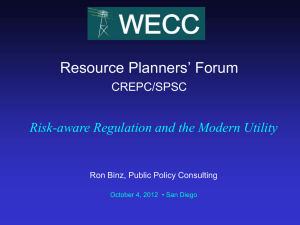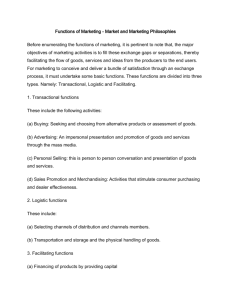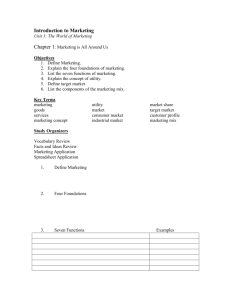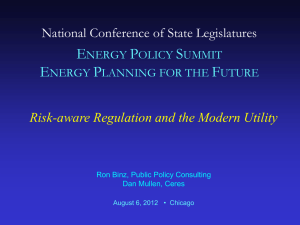New Utility Business Models
advertisement
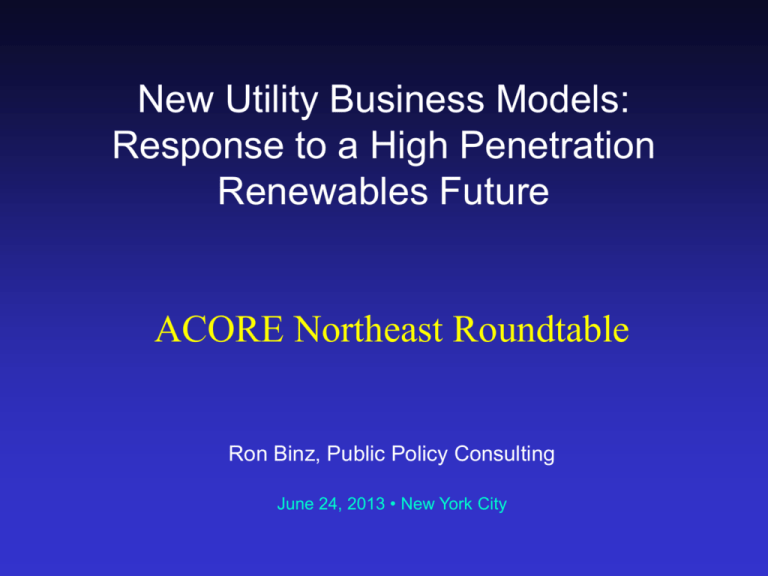
New Utility Business Models: Response to a High Penetration Renewables Future ACORE Northeast Roundtable Ron Binz, Public Policy Consulting June 24, 2013 • New York City • Thesis: Utilities are under great pressure to change – Aging plant • Brattle Group: $2 trillion investment over next 20 years – Tougher environmental requirements • Criteria pollutants • Greenhouse gases • Coal ash • Water restrictions – Flat to declining sales of electricity – New technologies • Smarter grid • Distributed generation: solar, CHP, micro turbines • Electric vehicles – Changing consumer requirements • Disintermediation by third parties – Weakened industry financial metrics US Electric IOUs Rating History 1970 – 2010 4% AA AA AA A 22% BBB 46% BBB- 27% A AA A A A BBB BBB BBB 1% Source: Standard & Poor’s, Macquarie Capital • Thesis: Regulation may not be up to the task – – – – May not reward utilities for desired behavior Society’s goals for utilities are changing; regulation is not Progress on demand side, not so much on supply side Lack of incentives for • • • • firm efficiency clean energy investment energy efficiency innovation – Rate structures need revision – Balky process – Examples of “poisoned” relationship – Entire orientation is based on utility as seller of a commodity Renewable Electricity Futures Study (REF) Exploration of High-Penetration Renewable Electricity Futures Available at NREL.gov EPRI’s 2009 View NREL’s REF Findings • Renewable electricity generation is more than adequate to supply 80% of total U.S. electricity generation in 2050 while meeting electricity demand on an hourly basis in every region of the country. • Increased electric system flexibility can come from a portfolio of supply- and demand-side options, like flexible conventional generation, grid storage, new transmission, more responsive loads, and changes in power system operations. • The are multiple paths using renewables that result in deep reductions in electric sector greenhouse gas emissions and water use. • The direct incremental cost with high renewable generation is comparable to costs of other clean energy scenarios. Helpful fact: The US summer peak electrical use is around 800 GW. Baseline Case REF ITI Case How does the assumption of an HREF affect the business model? Much higher levels of variable generation at the bulk power scale (affects utility organization, operations) Greater penetration of distributed energy resources at the distribution scale (affects utility revenues, services) Greater need for flexibility in the grid components, operations, and architecture (affects utility investment, operations) Much higher levels of energy efficiency (sufficient to eliminate load growth) (affects utility role, services) Utilities 2020 • Foundation funded • Run by two former state regulators named Ron • Advised by board of experts • Goal: to explore new business models and advocate new regulatory models to enable new utility business models to evolve. Advisory Council Members • John Bohn • – GlobalNet Partners, LLC • Paul Bonavia – Rocky Mountain Institute • – Tucson Electric Power • Ashley Brown Ralph Cavanagh • • Sonny Popowsky – PA Office of Consumer Advocate • – NRDC • John Nielsen – Western Resource Advocates – Harvard Electricity Policy Group • James Newcomb and Lena Hansen John Quackenbush – Michigan Public Service Commission Richard Cortright – Standard and Poor’s • Peter Fox-Penner – The Brattle Group • Lisa Schwartz – Regulatory Assistance Project V. John White – CEERT • Methods: – Interviews with utility CEOs and leading states regulators – Evaluations of other systems here and abroad – Dialogues with utility execs and commissioners Interviews • • • • • • • • • Paul Bonavia – Tuscon Electric Power David Eves – Xcel Energy Colorado Greg Abel – MidAmerican Energy Susan Story – Southern Company Energy Services Michael Yackira (five senior staff) – NV Energy Bob Rowe – Northwestern Energy Lewis Hay – NextEra Energy Ralph Izzo – PSE&G Tom King – National Grid • • • • • • • • • Colette Honorable – Arkansas PSC Susan Ackerman – Oregon PUC Phyllis Reha – Minnesota PUC Ellen Anderson – Minnesota PUC Joshua Epel – Colorado PUC John Quackenbush – Michigan PSC John Savage – Oregon PUC Jim Tarpey – Colorado PUC Ann Berwick – Massachusetts DPU Note: Organizational affiliations are shown for identification purposes only What we’ve heard from utility CEOs: • CEOs want a clearer, more consistent direction from state energy policies • Utilities have little incentive for innovation, firm level efficiency • Commissions need a better understanding of the utility business and its needs • Utilities want certainty on climate policy • Utilities want healthier working relationships with commissioners and staff What we’ve heard from commissioners: • A primary concern is with increasing utility rates • Regulators are open to modifying the regulatory model; looking for ideas • Some commissioners are dissatisfied with the adversarial process • Many commissioners face severe barriers to communications with stakeholders, and even fellow commissioners • Commissions have inadequate resources December meeting of the “Tribal Elders” • • • • • Peter Fox-Penner Tom King Ralph Cavanagh Lisa Wood Richard Sedano • • • • • Ron Lehr Ron Binz Ashley Brown* Jim Kerr* Sue Tierney* *Old enough, but unable to attend Findings from the Elders • The clean/efficient future is inevitable; utilities will need to adapt business models to accommodate the transformation. • Regulation must be reinvented to allow and induce utilities to change. • Load will likely be flat or declining in the future, but costs will not. Need to move away from consumption-based models toward service- and performance-based models. • This transition is best done as a partnership, not a system that attempts to bypass (leave behind) the utility. Findings from the Elders, cont’d. • There is an irreducible role for the utility as an “orchestra leader,” a role very similar to the “smart integrator” role in Smart Power. The UK has gone too far with industry disaggregation. • Regulation needs to move toward “output” regulation that rewards firms for outcomes, efficiency and innovation. The group coalesced around a “revenue cap” model with incentives for various outputs. (E.g., the UK RIIO model with decoupling) • These recommendations should be robust across different scenarios with/without wholesale or retail competition, IOU/public utility structure, etc. Motivations for a new regulatory model “We need to align regulatory incentives so that healthy utilities can pursue society’s broader policy goals in ways that also benefit customers and shareholders.” “Regulation has become confrontational, is often mired in judicial process, and exists amid a charged political setting. It’s hard to imagine a worse recipe for managing the transformation of the utility industry.” “A threshold question is whether state utility regulation will evolve to enable the necessary industry changes, or merely follow them, or worst, stand in the way.” UK regulation focus: Are we getting what we are paying for? US regulation focus: Did we pay the correct amount for what we got? Three Potential Regulatory Models • The UK “RIIO” model – Price cap built on RPI-X – Output regulation • Reliability, Environmental, Innovation, Price, Efficiency, Social Responsibility • The “Iowa Model” – Seventeen years of constant rates, settlements • The “Grand Bargain” – Comprehensive multi-year output-oriented deal – Regulator led Thanks for the invitation I look forward to your questions.

